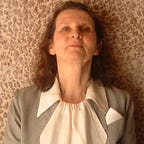Fractals, Compassion and Imagination
One is math, patterns, structures and the other is feeling, emotions, actions. Have you ever thought that there might be a link between the two? Well, I must admit that I did not even know what fractals were until last weekend. After all, I am someone who basically functions in a world of history, politics, beliefs, and cultures. However, I love my garden, my trees, my flowers, my herbs, the sound of birds chirping, the sight of a butterfly alighting on a flower.
This summer, back in Switzerland, where I spent at least seven years of my life, full, happy but challenging years, I was beside myself with joy as I ran with Houdini, a dog, next to vineyards, sunflower fields, and apple and pear orchards, all not far from a lake and encompassed by the majestic Alps and calming Jura mountains. I could not explain why I greeted the cows that I passed or followed unknown paths to see more trees and strike up conversations with the other humans who from time to time crossed my way.
But now, I know. The fractals, patterns repeated in my brain and in other forms stretching out to unfathomable size in the universe and fractals, patterns repeated in my and other bodies mirroring the fractals in the leaves of trees, were meeting and reaching out in recognition of each other.
A simple just over an hour presentation on fractals and neuroscience at a gathering on compassion unlocked a link between the unimaginable microworld with its equally inconceivable macroworld. Myself, seeming meaningless in the gigantism of our galaxy, I was connected to it and the subatomic particles that make us one and could understand why, though I do swat flies in my kitchen, I opened the screen door so that one, which wanted to get out into the garden, was able to do so.
Neuroscience, I learned, has shown that simple contact with nature soothes and has a beneficial effect upon us, homo sapiens. It became clear to me why the saddest years of my life were those I spent in an apartment with only one tree to look at in an enclosed street with house upon house. Those were the years when I escaped by eating, leading to a twelve-year-old encased in fat and suffering from life threatening high blood pressure, a child saved by a typewriter which led to words that released the mind to imagined fields and woods. It pointed out why every place I chose to live in after that included at least a space with grass and brush and makes me realize that nature is my mantle.
I finally sensed what drew me in college to spend whole nights in front of a big telescope trying to catch which stars emitted blue light and which emitted a reddish one. Having taken a course in astronomy because I was forced to diversify from my normal historical and political science bent, I was so enthralled by the patterns in the vastness above me that I did better in this subject than in those of my chosen field, leading the professor to ask whether I wouldn’t consider staying on for a second major.
I understood why as a young interpreter at the United Nations I wound up volunteering to interpret for the scientists who gathered at the Center of Nuclear Research in Geneva. There was no way I could stay away from the wondrous call to look at the depths of being through what were considered the minutest particles at that time, just as years later I could not stay away from imbibing and feeling it through the lenses of various cultures and beliefs. Note, by the way, that I left Geneva before the first formal book on fractals had appeared.
Whatever our differences we, humans, are from the tiniest part of us reflections of each other in the vastness of the cosmos. I was tempted to write ‘universe’ but then, laughed to myself. In a concluding session of the conference, a medical doctor asked us how old we were. Sitting at least thirty feet from him, I thought about it for a moment and concluded ‘billions of years old.’ He came out with the fact that we are as old as the universe with the particles of the ‘big bang’ that started it all, over thirteen billion years ago. I smiled.
A little later, as he was seated at a table, I approached him and said, “Well, the big bang and the theory of one universe, are being contested more and more. There are now scientists who say that there are many universes and no big bangs. We are getting closer to infinity…” Perhaps, the fractals in my brain, reflecting fractals in incalculable space and time, were working on my thoughts.
